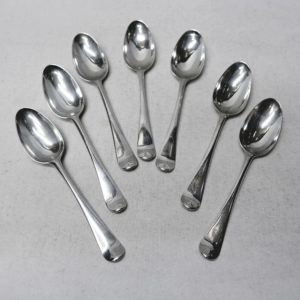Thomas Evans And George Smith III
Thomas Evans and George Smith III. The unregistered mark of TE/GS is usually attributed to a known partnership between Thomas Evans and Gerge Snith III. Goldsmiths Hall have a recird of their partnership 1769-1771.
Thomas Evans I, is recorded as a spoonmaker, East Harding St, 1766. He appears in the Parliament report list of 1773 as spoonmaker, Wood St, but no mark is recorded for him before this date. His son Thomas Evans II was apprenticed to his father, 1765 and turned over the same day to Thomas Wooton. The following marks, all registered with identical signatures, could be attributable to either of the two silversniths. 1st mark as spoonmaker 1774, Second mark (small) 177. Bankrupt 1779. 3rd mark 1779. 4th mark 1782. 5th mark as plateworker 1782. 6th mark as smallworkerin partnership with Jacob Levi 1784. 7th mark alone 1784. 8th mark 1786. 9th as smallworker 1792.
George Smith III and IV. The number of London silversmiths called George Smith in the 18th Century is very confusing. The spoonmakers were father and son, and are generally referred to as George Smith III and IV, and were unrelated to I, II, V & VI. Both used the mark “GS”.
George Smith III was apprenticed to Thomas Chawner in 1765, turned over to Pierce Tempest, freedom unrecorded. 1st mark as spoonmaker 1774. 2nd–5th marks 1774, 1775, 1776, 1776, 1778. 6th (2 sizes) 1780. 7th (5 punches) 1782. 8th in partnership with William Fearn 1786.
His son George Smith IV was apprenticed to William Fearn in 1786 and worked from 1799-1807.
Thomas Evans And George Smith III
Thomas Evans and George Smith III. The unregistered mark of TE/GS is usually attributed to a known partnership between Thomas Evans and Gerge Snith III. Goldsmiths Hall have a recird of their partnership 1769-1771.
Thomas Evans I, is recorded as a spoonmaker, East Harding St, 1766. He appears in the Parliament report list of 1773 as spoonmaker, Wood St, but no mark is recorded for him before this date. His son Thomas Evans II was apprenticed to his father, 1765 and turned over the same day to Thomas Wooton. The following marks, all registered with identical signatures, could be attributable to either of the two silversniths. 1st mark as spoonmaker 1774, Second mark (small) 177. Bankrupt 1779. 3rd mark 1779. 4th mark 1782. 5th mark as plateworker 1782. 6th mark as smallworkerin partnership with Jacob Levi 1784. 7th mark alone 1784. 8th mark 1786. 9th as smallworker 1792.
George Smith III and IV. The number of London silversmiths called George Smith in the 18th Century is very confusing. The spoonmakers were father and son, and are generally referred to as George Smith III and IV, and were unrelated to I, II, V & VI. Both used the mark “GS”.
George Smith III was apprenticed to Thomas Chawner in 1765, turned over to Pierce Tempest, freedom unrecorded. 1st mark as spoonmaker 1774. 2nd–5th marks 1774, 1775, 1776, 1776, 1778. 6th (2 sizes) 1780. 7th (5 punches) 1782. 8th in partnership with William Fearn 1786.
His son George Smith IV was apprenticed to William Fearn in 1786 and worked from 1799-1807.
-


1770
Thomas Evans And George Smith III
8800 Antique George III Silver Spoons
Sold
A set of 7 antique sterling silver spoons in the popular Hanoverian rat-tail pattern. Lovely plain style. Each with a hand engraved monogram to the reverse. Weight 288 grams, 9.2 troy ounces. London 1770. Length 16 cms. Maker Thomas Evans and George Smith.